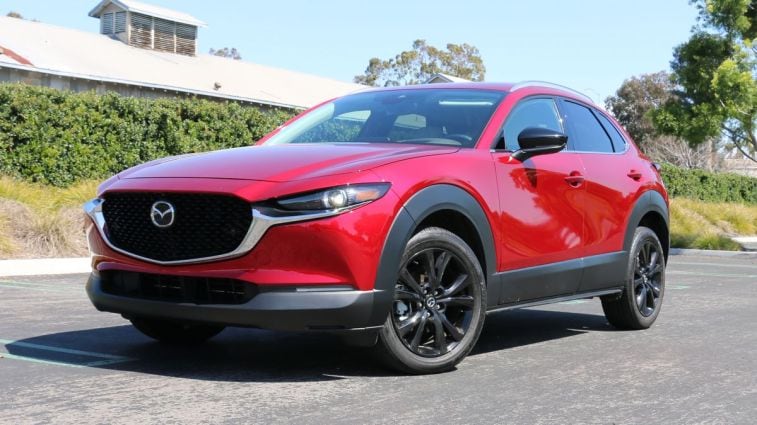The subcompact SUV segment is full of compelling options. Small SUVs have become popular entry-level vehicles for young people buying their first new car or anyone looking for an affordable, practical vehicle. In this crowded segment, knowing which SUV is best for your wants and needs and which provides the best value can be challenging.
The Kia Soul and Mazda CX-30 are two subcompact SUVs with different sets of strengths. Let’s take a closer look and determine which is suitable for which buyer.
2024 Kia Soul
The Kia Soul comes from an era when small, boxy cars were a bit of a fad, but it’s endured as the only survivor of that trend. It’s not hard to see why. The Soul is a surprisingly roomy car with a distinct aesthetic at an affordable price. Pricing starts at $21,565, including the destination fee.
Kia Soul Highlights
Outstanding warranty: The Kia Soul boasts a class-leading warranty, giving the driver extra peace of mind. It’s backed by a 5-year/60,000-mile basic warranty and a 10-year/100,000-mile powertrain warranty. That beats the Mazda’s 3-year/36,000-mile basic warranty and 5-year/60,000-mile powertrain warranty.
More interior space: Even though the Mazda is about 8 inches longer than the Kia, the Soul has more interior space. The space-efficient Kia Soul has 2.5 extra inches of rear legroom and a whopping 62.1 cubic feet of maximum cargo space. That’s 37% more cargo room than the CX-30.
Affordable and efficient: In addition to the lower starting price compared to the Mazda, the Kia Soul is more fuel-efficient than the CX-30. The Soul gets a combined fuel economy rating of up to 31 mpg, but the most efficient CX-30 gets up to 29 combined mpg.
Check this week’s Fair Purchase Price or see the Soul models for sale near you.
2024 Mazda CX-30

The Mazda CX-30 is the smallest and most affordable entry in the compelling Mazda SUV lineup. It’s a sporty and upscale offering in this class, and its standard all-wheel-drive system makes it ready for harsh winters or mild off-roading. Pricing starts at $26,370, including the destination fee.
Mazda CX-30 Highlights
All-wheel drive: All-wheel drive is standard in the Mazda CX-30 but unavailable in the Kia Soul. It gives the Mazda an edge if you live in a snowy climate or want to do some occasional off-roading.
Available turbo engine: While the Soul prioritizes efficiency over performance, the Mazda CX-30 has an available turbo engine producing up to 250 horsepower and 320 lb-ft of torque. It gives the CX-30 the driving excitement we love about the Mazda brand.
Upscale interior: Part of the reason the Mazda CX-30 costs more than the Kia Soul is its more luxurious cabin. It has a simple yet pleasing interior design made with nicer materials than you might expect at this price point. A few premium options include a Bose 12-speaker sound system, leather seats, and a power liftgate.
Check this week’s Fair Purchase Price or see the CX-30 models for sale near you.
Similarities
These two SUVs are sized similarly enough to both be considered subcompact SUVs. They also both come standard with a naturally aspirated 4-cylinder engine and similar safety and infotainment tech features.
Conclusion
The Kia Soul makes a strong case as the more frugal and practical choice. It’s cheaper, roomier, more efficient, and has a longer warranty. However, the enthusiast in us prefers the Mazda CX-30. The interior is nicer, it’s more fun to drive with the optional turbo engine, and we like that it comes standard with AWD. Which SUV is right for you depends on your priorities.
| 2024 Kia Soul | 2024 Mazda CX-30 | |
| Starting Price | $21,565 | $26,370 |
| Popular Powertrains | ||
| Engine | 2.0-liter 4-cylinder | 2.5-liter 4-cylinder |
| Horsepower | 147 hp @ 6,200 rpm | 191 hp @ 6,000 rpm |
| Torque | 132 lb-ft @ 4,500 rpm | 186 lb-ft @ 4,000 rpm |
| Transmission | CVT automatic | 6-speed automatic |
| Fuel Economy | 29 city/35 highway/31 combined mpg | 26 city/33 highway/29 combined mpg |
| Also Available | Turbocharged 2.5-liter 4-cylinder | |
| Specs | ||
| Basic Warranty | 5 years/60,000 miles | 3 years/36,000 miles |
| Powertrain Warranty | 10 years/100,000 miles | 5 years/60,000 miles |
| NHTSA Overall Safety | 4 stars | 5 stars |
| Max Seating Capacity | 5 | 5 |
| Wheelbase | 102.4 inches | 104.4 inches |
| Overall Length | 165.2 inches | 173 inches |
| Width | 70.9 inches | 70.7 inches |
| Height | 63 inches | 61.7 inches |
| Turning Diameter | 34.8 feet | 34.8 feet |
| Headroom, Front | 39.9 inches | 38.1 inches |
| Headroom, 2nd Row | 39.5 inches | 38.3 inches |
| Legroom, Front | 41.1 inches | 41.7 inches |
| Legroom, 2nd Row | 38.8 inches | 36.3 inches |
| Shoulder Room, Front | 55.5 inches | 55.6 inches |
| Shoulder Room, 2nd Row | 54.7 inches | 53.6 inches |
| Cargo Volume Rear Seats Up/Down | 24.2/62.1 cubic feet | 20.2/45.2 cubic feet |
Source link

